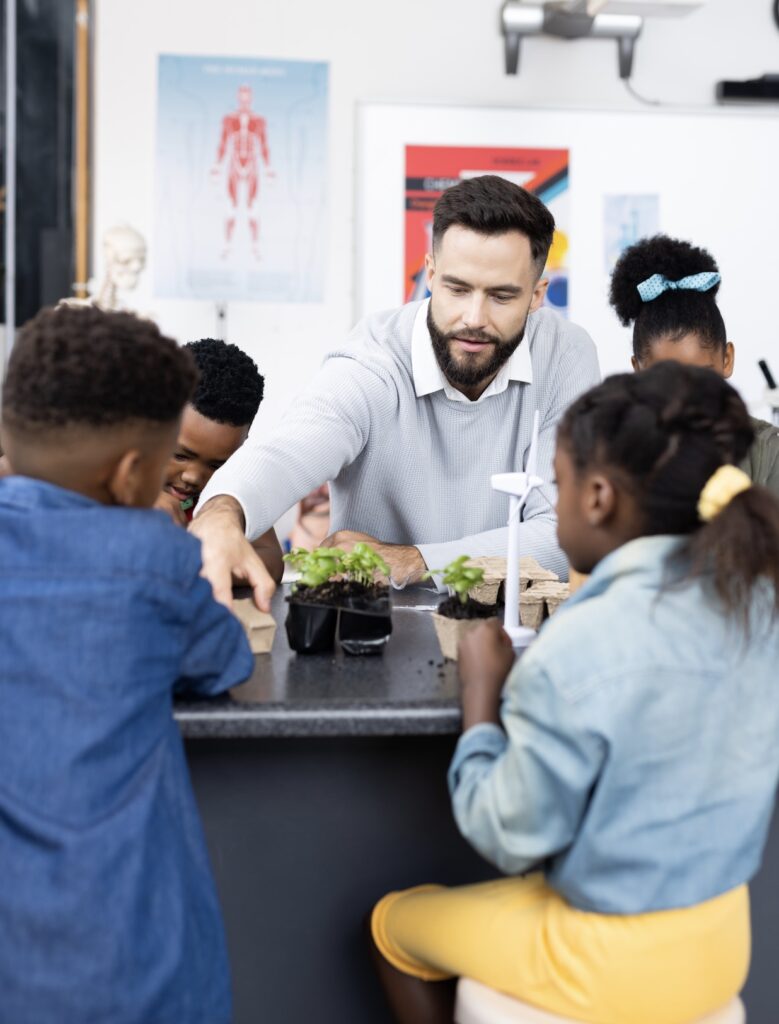On this page, we explain how you (the teacher) would apply the concept of Africanisation in your teaching: Incorporating the concept of Africanisation into...
On this page, we discuss the specific skills and knowledge required in the teaching and learning of science:
As a teacher, diving into the realm of science education requires a blend of specific skills and knowledge, both to captivate the curiosity of students and to navigate the complexities of scientific concepts effectively. Here’s a closer look at what’s needed:
The specific skills and knowledge required in the teaching and learning of science, particularly for teachers, include:
- Deep Content Knowledge: A strong foundation in scientific principles and concepts across various disciplines, along with an ability to stay current with scientific advancements.
- Pedagogical Expertise: Proficiency in employing inquiry-based learning, adapting teaching strategies to suit diverse learning styles, and fostering a hands-on, exploratory classroom environment.
- Skillful Use of Technology: The ability to effectively integrate digital tools and resources, such as virtual labs and simulations, to enhance student learning and engagement.
- Effective Assessment Strategies: Skills in designing and implementing assessments that accurately measure student understanding and application of scientific concepts, coupled with providing constructive feedback.
- Classroom Management for Science Education: Managing the unique dynamics of a science classroom, including safety protocols for experiments, while fostering a respectful and inclusive learning environment.
- Communication Skills: The ability to convey complex scientific ideas in a clear, accessible manner and to encourage a classroom culture where students feel comfortable to inquire and express their thoughts.
- Nurturing Critical Thinking and Inquiry: Facilitating an environment that encourages students to think critically, solve problems using the scientific method, and engage deeply with the material through questioning and exploration.
- Cultivating Collaboration and Communication Among Students: Promoting teamwork and effective communication within the classroom, essential for scientific inquiry and problem-solving.
Skills and Knowledge Required in the Teaching and Learning of Science

1. Deep Content Knowledge
First and foremost, a thorough understanding of the subject matter is crucial. This means being well-versed in the principles, theories, and facts of the scientific disciplines you’re teaching, from biology and chemistry to physics and earth science. It’s not just about the basics; staying updated with the latest scientific research and developments enriches your teaching and keeps it relevant.
Example: When teaching about ecosystems, a teacher with deep content knowledge can integrate discussions on the latest research about climate change’s impact on coral reefs. This could involve exploring case studies and current events, making the lesson more relevant and engaging.
2. Pedagogical Expertise
Understanding how students learn science is a requirement in the teaching and learning of science. This involves mastering inquiry-based learning techniques, which encourage students to explore, ask questions, and engage deeply with the material. It’s about creating lessons that aren’t just informative but also interactive and exploratory, fostering a hands-on learning environment.
Example: Utilizing an inquiry-based learning approach, a teacher might start a unit on electricity by having students first list their daily activities that require electricity. Then, students could formulate questions about how electricity is generated, leading to a research project or experiment on creating simple circuits.
3. Skillful Use of Technology
Technology plays a pivotal role in modern science teaching, and it is a requirement in the teaching and learning of science. Familiarity with digital tools and resources, like virtual labs, simulations, and online databases, can greatly enhance the learning experience. It’s about leveraging these technologies to make complex concepts more accessible and engaging for students.
Example: In a lesson on human anatomy, a teacher could use virtual dissection tools or 3D modeling software to explore the human body’s systems. This approach allows students to visually and interactively learn about anatomy without the need for physical dissection kits.
4. Effective Assessment Strategies
Assessing student understanding in science goes beyond traditional tests and quizzes. It involves crafting assessments that truly measure students’ grasp of concepts and their ability to apply them. This might include lab reports, projects, presentations, and practical experiments, along with formative assessments that guide your teaching strategy.
Example: After a unit on chemical reactions, instead of a standard test, students could be tasked with designing an experiment to demonstrate a reaction. They would predict the outcome, conduct the experiment, and present their findings, including a discussion on why the reaction occurred as it did.
5. Classroom Management for Science Education
Science classrooms are unique. They often involve laboratory work and experiments, which means, as a science teacher, you need to be adept at managing not just student behavior but also safety protocols. Ensuring a safe, organized, and respectful learning environment is key to facilitating effective science learning.
Example: During lab work, a teacher might assign specific roles (e.g., equipment manager, note-taker, safety officer) to each student in a group to ensure safety and efficiency. Clear instructions, expectations, and swift response to any safety concerns help maintain a productive learning environment.
6. Communication Skills
The ability to communicate complex scientific ideas in a way that’s accessible and engaging is perhaps one of the most critical skills required in the teaching and learning of science. This includes not just verbal explanations but also the use of visual aids, storytelling, and analogies to make abstract concepts tangible.
Example: To explain the concept of photosynthesis, a teacher might use a storytelling approach, narrating a day in the life of a leaf and how it converts sunlight into food. This narrative technique can make the process more relatable and easier to grasp for students.
7. Nurturing Critical Thinking and Inquiry
A significant part of science education is teaching students to think like scientists. This means encouraging critical thinking, problem-solving, and the scientific method itself. Students should be equipped to formulate questions, conduct investigations, analyze data, and draw evidence-based conclusions.
Example: In exploring the topic of genetic variation, students could be given different scenarios (e.g., environmental changes) and asked to predict how these might affect animal populations. Through discussion and research, they develop hypotheses, fostering critical thinking and understanding of natural selection.
8. Cultivating Collaboration and Communication Among Students
Science is often a collaborative endeavor. Encouraging students to work together on projects, experiments, and problem-solving activities teaches them the value of teamwork and diverse perspectives. It also helps them develop the communication skills necessary to share their ideas and findings effectively.
In sum, teaching science is about much more than just delivering content; it’s about creating an environment where curiosity thrives, questions are welcomed, and learning is an active, engaging process. By developing these specific skills and knowledge, you can inspire the next generation of scientists and innovators, equipping them not just for academic success but for lifelong inquiry and discovery.







